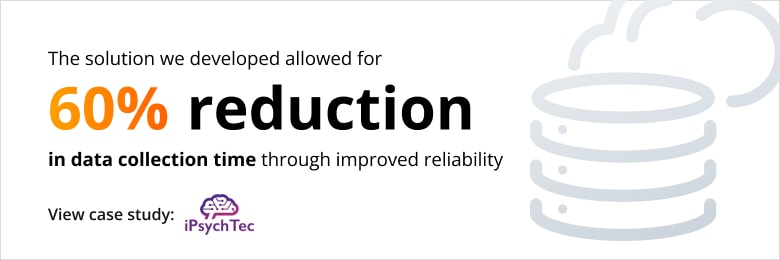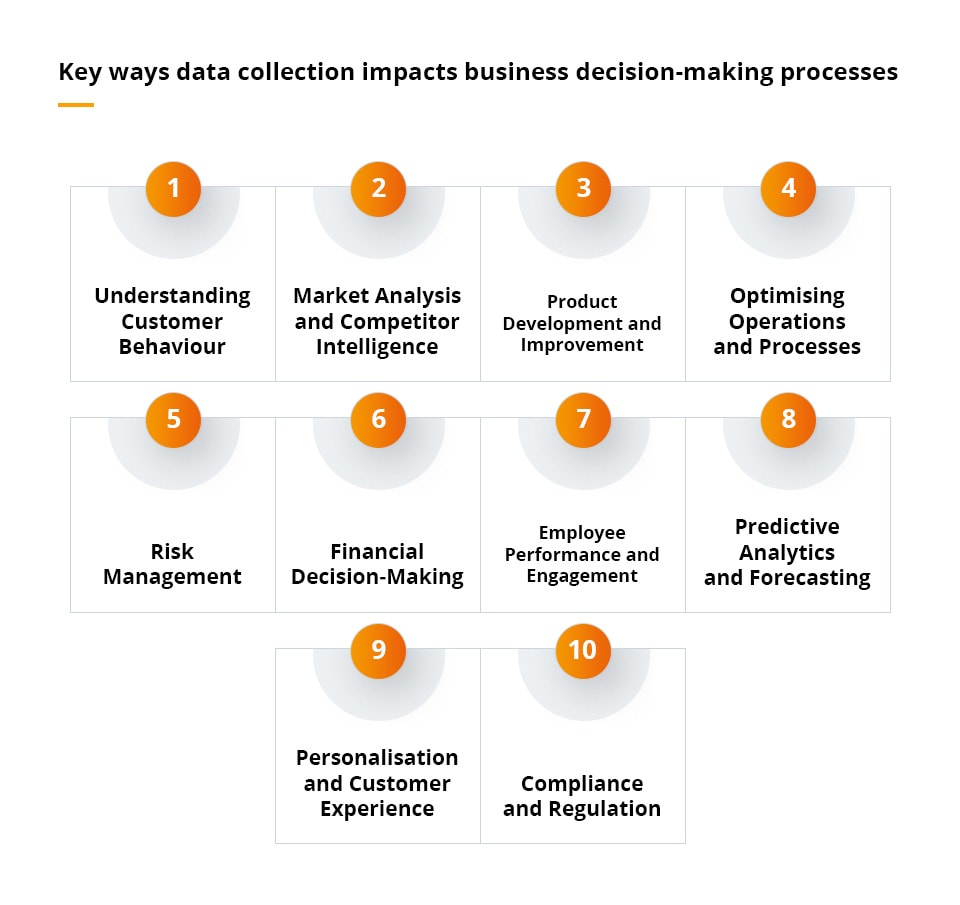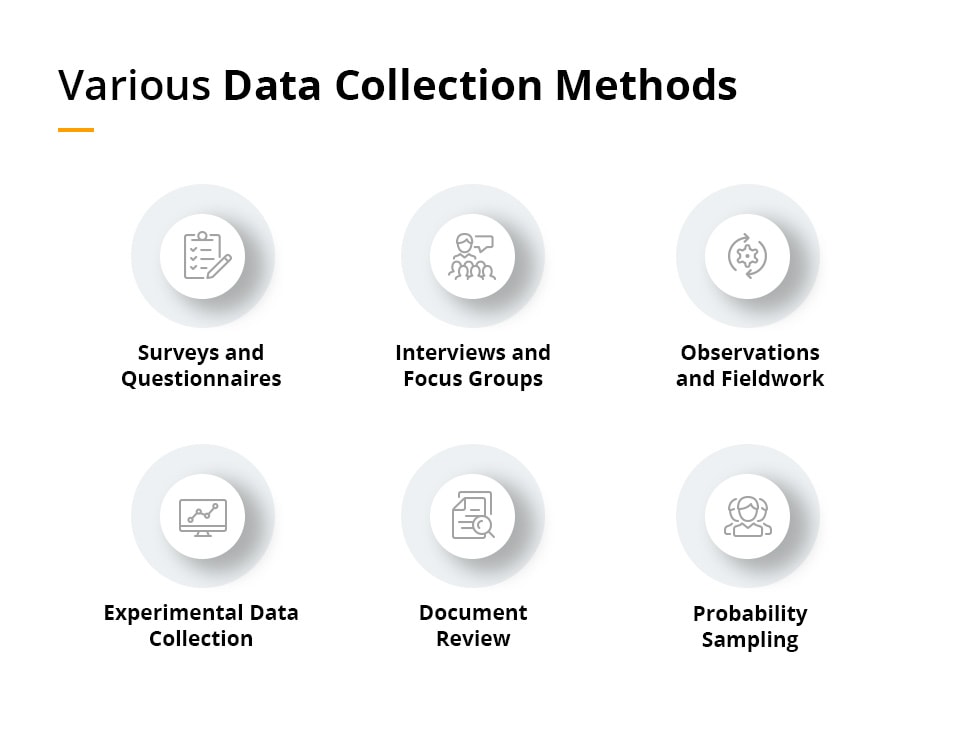
Data collection (data gathering): methods, benefits and best practices
We produce data on a daily basis – statistics say this year we will create 120 zettabytes of data and by 2025 the number will increase to 181 zettabytes. How to make sure data we gather is relevant, important and used in the right way?
Data collection: definition and introduction
Before we dive into details, let’s look at some definitions.
Data collection refers to the process of gathering and acquiring information, facts, or observations from various sources, in a systematic and organised manner. The collected data can be used for various purposes, such as research, analysis, decision-making, and problem-solving.
In today’s digital age, data collection has become increasingly prevalent and crucial, as it enables organisations and individuals to gain insights and make informed choices based on empirical evidence.
The role of data collection in business decision making
Data collection plays a central role in business decision-making by providing the necessary information and insights for organisations to make informed choices and formulate strategies.
In the modern business landscape, where data is abundant, businesses that can effectively collect, analyse, and interpret data have a significant competitive advantage.
Request for Proposal (RFP) for Data Solutions
Download our comprehensive tool for data leaders
Some key ways data collection impacts business decision-making processes include:
Understanding Customer Behaviour
Data collection allows businesses to gather information about their customers’ preferences, purchasing behaviour, and demographics. By analysing this data, businesses can identify trends and patterns, enabling them to tailor their products, services, and marketing strategies to better meet customer needs.
Market Analysis and Competitor Intelligence
Data collection helps businesses gain insights into market trends, industry performance, and competitor strategies. Analysing market data can help identify new opportunities, potential threats, and areas where a company can differentiate itself from competitors.
Product Development and Improvement
Through data collection, businesses can gather feedback from customers about their existing products and services. This feedback can be used to make improvements, address issues, and develop new offerings that align with customer preferences.
Optimising Operations and Processes
Data collection can be applied to internal operations, supply chain management, and production processes. Analysing operational data can lead to efficiency, cost reductions, and streamlined workflows, ultimately improving the overall performance of the business.
Risk Management
Data collection and analysis help businesses assess potential risks and vulnerabilities. By monitoring key performance indicators and relevant market data, companies can anticipate challenges and make proactive decisions to mitigate risks.
Financial Decision-Making
Financial data collection is crucial for budgeting, financial planning, and resource allocation. Accurate financial data enables organisations to make strategic decisions related to investments, pricing, and revenue management.
Employee Performance and Engagement
Data collection can extend to employee feedback, performance metrics, and engagement surveys. Understanding employee satisfaction and performance can lead to a more productive and motivated workforce.
Predictive Analytics and Forecasting
Data collection provides the foundation for predictive analytics, which involves using historical data to forecast future trends and outcomes. This capability helps businesses make proactive decisions rather than reacting to events after they occur.
Personalisation and Customer Experience
By collecting and analysing customer data, businesses can offer personalised experiences and targeted marketing campaigns, improving customer satisfaction and loyalty.
Compliance and Regulation
In industries with strict regulatory requirements, data collection plays a vital role in ensuring compliance and meeting reporting obligations.
The types of data collection: primary and secondary data gathering
Data collection can take many forms, including primary and secondary data gathering. Here is an overview of how they differ:
- Primary Data Collection involves gathering original data directly from the source. Researchers or data collectors interact with individuals or entities to collect information through methods like surveys, interviews, questionnaires, observations, or experiments.
- Secondary Data Collection involves using data that has already been collected by others. This data can come from a wide range of sources, such as government agencies, research institutions, public databases, or other existing datasets. Analysing and utilising secondary data can save time and resources but might be less tailored to the specific needs of the current study.
Quantitative vs qualitative data gathering
Other types of data collection are called quantitative and qualitative data gathering methods. This is what they involve:
- Qualitative Data Collection focuses on obtaining non-numeric data, often used in social sciences, humanities, and other fields where understanding context, behaviours, and opinions is essential. Qualitative data can be collected through interviews, focus groups, content analysis, and more.
- Quantitative Data Collection focuses on gathering numeric data that can be analysed statistically. Examples are surveys, experiments, structured observations, and sensor data.
In-depth examination of various data collection methods
Data collection methods can vary based on the nature of the data being sought, the research objectives, available resources, and the target population. Let’s look at some data collection methods in use:
Surveys and Questionnaires
Surveys and questionnaires involve gathering information from a sample of individuals through a set of structured questions. They can be conducted on paper, via online questionnaires, telephone interviews, or face-to-face interviews.
They are efficient in collecting data from a large number of respondents and provide standardised responses for easy analysis. It’s worth remembering though that the wording and framing of survey questions can influence responses, and response rates may be affected by survey fatigue.
Interviews and Focus Groups
Interviews involve direct one-on-one or group interactions with participants to gather qualitative or quantitative data. Interviews can be structured, semi-structured, or unstructured, depending on the level of flexibility needed. They allow for in-depth exploration of topics and offer opportunities to clarify responses and probe deeper into participants’ perspectives. On the other hand, they can be time-consuming, and the presence of the interviewer may introduce bias.
Observations and Fieldwork
Observational data collection involves systematically watching and recording behaviours, events, or interactions in a natural setting. Observations provide firsthand, real-time data and are useful for studying behaviours or phenomena in their natural context. They can however be influenced by the observer’s bias, and certain behaviours may be difficult to capture unobtrusively.
Experimental Data Collection
Experimental data collection involve manipulating one or more variables to observe their effect on the outcome of interest. They are often conducted in controlled settings. Such experiments establish cause-and-effect relationships and allow researchers to control extraneous variables, but they may not fully capture real-world complexities, and ethical considerations must be taken into account when manipulating variables.
Document Review
Document review involves the systematic examination and analysis of existing documents, records, or artifacts to extract relevant information. It is cost-effective, time-saving and non-invasive. It’s important to remember though that the accuracy, reliability, and completeness of the data depend on the quality and credibility of the source documents.
Probability Sampling
Probability sampling is used to select a representative sample from a larger population and involves random selection, ensuring that every element in the population has an equal probability of being chosen. Its advantages include generalisability, statistical inference and reduced bias. Yet it’s worth remembering that implementing probability sampling can be more challenging and time-consuming compared to non-probability sampling methods.
Consequences of poor data collection: the hidden risks
Poor data collection can have far-reaching consequences such as flawed decision-making, compromised insights, and potentially damaging outcomes. Let’s look at them in more detail:
- Inaccurate analysis and decisions – If data collection is flawed or incomplete, the insights derived from the data will be inaccurate or misleading. Businesses may make ill-informed decisions that could lead to financial losses, missed opportunities, or ineffective strategies.
- Biased results – Poor data collection can introduce bias into the data, either through the sampling process or the design of survey questions. Biased data can lead to unfair conclusions or discriminatory practices, affecting individuals or certain groups.
- Missed opportunities and trends – Inadequate data collection may result in missing critical information and trends. Organisations might fail to identify emerging market opportunities, customer preferences, or potential threats, putting them at a competitive disadvantage.
- Reputation damage – If data collected is mishandled, misused, or exposed due to inadequate security measures, it can lead to a breach of trust with customers, partners, or the public. This can damage an organisation’s reputation and result in a loss of customer loyalty.
- Wasted resources – Poor data collection can lead to the collection of irrelevant or duplicate data. This wastes time, effort, and resources that could have been better allocated elsewhere.
To mitigate those consequences, it is essential to prioritise data quality, establish rigorous data collection procedures, and invest in data management systems and technologies.
Request for Proposal (RFP) for Data Solutions
Download our comprehensive tool for data leaders
Data collection best practices: nailing it right
As we discussed above, data collection is a critical process that lays the foundation for accurate analysis and informed decision-making.
To ensure success and maintain the integrity of data collection, several best practices should be followed:
Ensuring Accuracy in Data Collection
Ensuring accuracy in data collection is crucial to obtaining reliable and trustworthy information for analysis and decision-making. Key practices to achieve that include clearly defining research objectives, using valid and reliable data collection instruments, following standardised data collection methods, ensuring clarity and precision throughout the process and monitoring the system regularly to ensure errors are detected early on.
Maintaining Ethical Standards in Data Collection
Maintaining ethical standards in data collection is essential to protect the rights and well-being of individuals and to ensure the integrity and trustworthiness of research and business practices.
Key principles and practices to adhere include:
- obtaining informed consent from all participants before collecting their data,
- protecting participants by ensuring their personal information is kept confidential and secure,
- collecting only the data necessary to address the research objectives,
- having respect for vulnerable populations and respecting culture and social norms.
Data Privacy and Security: A Non-negotiable Aspect
Data privacy and security are non-negotiable aspects in all data collection methods. To achieve them, remember to protect individual rights, build trust, mitigate data breach risks, comply with regulations and safeguard sensitive information.
Implementing strong security measures, obtaining informed consent, conducting data protection impact assessments, and staying up-to-date with data protection regulations are essential steps in ensuring data privacy and security. These efforts not only protect individuals’ rights but also contribute to a more trustworthy and responsible data-driven society.
Overcoming challenges in data collection: create an effective strategy
Creating an effective data collection strategy involves careful planning, consideration of potential challenges, and the implementation of solutions to overcome them. Here’s our step-by-step guide to developing one:
- Define clear objectives: Start by clearly defining your research or business objectives. Understand what data you need to collect, why you need it, and how it will be used to achieve your goals.
- Identify data sources: Determine the sources from which you will collect data. This could include primary sources (surveys, interviews, observations) or secondary sources (existing databases, public records, literature reviews).
- Choose appropriate data collection methods: Select data collection methods that align with your objectives and the nature of the data you need. Ensure that the chosen methods are suitable for the target population and are likely to give reliable results.
- Design data collection instruments: If applicable, design data collection instruments such as surveys, questionnaires, or interview guides. Ensure that they are clear, unbiased, and relevant to your research objectives.
- Pilot test the instruments: Before full deployment, pilot test your data collection instruments with a small group of participants to identify and address any issues, ambiguities, or errors.
- Address sampling challenges: If your data collection involves sampling, carefully address potential sampling challenges. Use probability sampling when possible to ensure representativeness, and pay attention to issues like non-response bias or sample size.
- Train data collectors: If data collection involves human interaction, provide comprehensive training to data collectors to ensure consistency and standardisation in the data collection process.
- Establish data privacy and security protocols: Implement robust data privacy measures to protect participant information and ensure compliance with relevant data protection laws. Establish secure data storage and access controls.
- Minimise non-sampling errors: Identify and minimise non-sampling errors, which can occur during data entry, data recording, or data processing. Conduct regular data quality checks to ensure accuracy.
- Anticipate and address data collection challenges: Identify potential challenges that could arise during data collection, such as low response rates, uncooperative participants, or incomplete data. Develop strategies to address these challenges proactively.
- Monitor data collection progress: Regularly monitor the progress of data collection to ensure it is on track and meeting the objectives. Be prepared to make adjustments if needed.
- Maintain clear communication: Communicate with stakeholders and participants clearly and transparently about the data collection process, its purpose, and the importance of their participation.
- Record detailed documentation: Keep detailed documentation of the data collection process, including any modifications, issues encountered, and how they were resolved.
- Plan for data analysis and utilisation: Consider how the collected data will be analysed and utilised to achieve the research or business objectives. Ensure that the data collected is relevant and sufficient for your analytical needs.
- Evaluate and improve: After data collection is complete, evaluate the effectiveness of your data collection strategy and identify areas for improvement in future projects.
A good strategy is always key. But if you are keen to do it right, you may need to work with specialists, experienced in this kind of projects.
At Future Processing we offer several data solutions that may have huge impact on your business. Get in touch with our team to see how you can make the most of your information assets and take your organisation to the next level.








